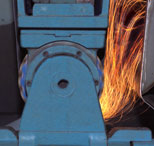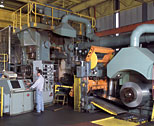There are several ways we make clad metals at EMS, chief among them a continuous roll bonding process that combines two or more strips of metal.
Cleanliness is paramount, so first, the individual strips are chemically or mechanically cleaned to provide contaminant-free surfaces. The strips then pass through a highly customized rolling mill designed specifically for cladding.
As they pass through the mill, the rolls exert immense pressure that reduces strip thickness and creates a metallurgical bond as the atomic lattices of the different metals merge into a common structure. The resulting composite material – a clad metal – derives its integrity from this shared electron interface.
Heat is then applied to induce diffusion, which improves bond strength and provides stress relief for cold processing. The result: a clad metal imbued with precisely the right properties for its specific application.
And that is the key benefit of cladding: the ability to combine the most desirable characteristics from different metals into a unique new metal composite that lets you do things you couldn't do before.


